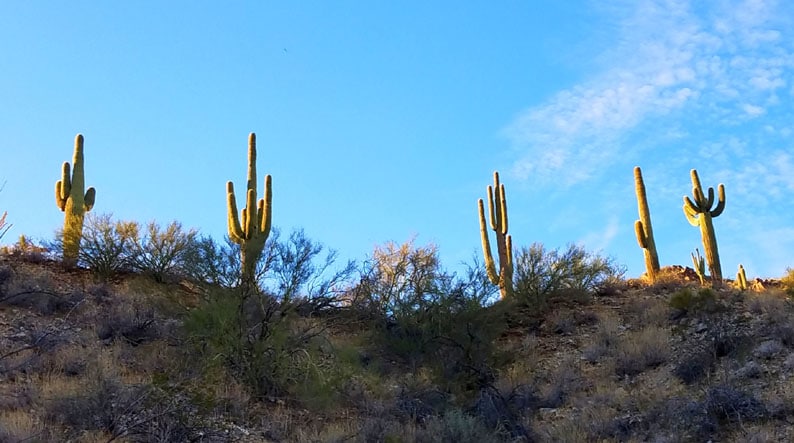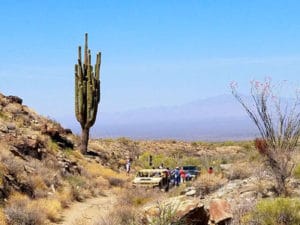A cactus is one of the most well-liked features of the Arizona desert, sprouting up out of the ground seemingly at random in the most barren areas. Cacti as they call them in plural form are some of the toughest most resilient plants out there, able to go for months on end with absolutely no water, and living for hundreds of years, the Saguaro cactus is the most prominent of them all.
Saguaros are what most people think of when they imagine a cactus, a tall trunk in the middle with and arm on each side a bit lower than the main trunk. These plants almost resemble people like stick figures, and they are all unique. Sometimes they grow many arms creating a wide stance, and then sometimes they don’t grow as many arms but will grow tall, and occasionally will not grow any arms at all. While the types of dirt or soil they grow in or the areas of water runoff may cause this, it is still unknown as to why they vary so much in their composition.
Life of a Saguaro cactus
These cactus are typically 10ft to 20ft tall on average, but it is common to see them between 25ft and 30ft tall as well, with real monsters reaching over 40ft tall in some circumstances. These are easily the largest plants in the desert as they tower over any of the trees that grow out here. They are also astoundingly old. A simple, ‘small’ 6ft tall armless saguaro is nearly 75 years old, and will not grow their first arm until they are 100 years old. A healthy cactus with a number of arms and height of 15ft to 20ft is easily 150 years old and anything over 40ft tall is well over 200 years old. There’s no doubt that the largest saguaros you see predated both American and Mexican colonization of Arizona, and were easily present during the final years of Spanish conquest for New Spain.
Saguaro a protected cactus
These cactus are also very protected and though are not particularly considered an endangered species, they only grow in Arizona and northern Mexico, with a few isolated populations in far eastern California. They have a very specific range for growth that also limits their presence in certain areas. They only grow naturally up to 4,000ft of elevation above sea level, though they will more comfortably and commonly grow between 2,000ft and 4,000ft. But once they plant their root, they are typically there to stay.
Like many cactus varieties, they will flower and bloom in spring, and store water in their trunks and arms to make it through droughts and dry spells. Too much water can be a problem for these cacti as they can get too heavy and fall over. Very often a saguaro will meet it’s demise by getting too tall and collapsing over it’s own weight, or by getting struck by lightening as they are the tallest objects in the desert.
Saguaro cactus on the ranch
At Stagecoach Trails Guest Ranch, we have one very small saguaro in front of the lodge that is slowly making it’s way into the world, but at 4ft tall, it has many years to go before it reaches an impressive height; perhaps the young children that visit the ranch today can come back in 70 years to see it grow it’s first arms!
Fortunately one of our most common and beloved horseback rides is to ‘Cactus Hill’, where two prominent saguaros grow on the very top of a small mountain that we go up and over. This is one of the best ways to see one of these magnificent marvels of nature up close and personal. You also can see these giants on one of our ATV tour destinations to the mountains, where they are abundant and quite large. Even though we are at the extreme northern limit of these giant cacti, we are still able to see and experience them with our guests. There is nothing more Arizonan than seeing these plants are you ride off in the backdrop of a serene sunset.



